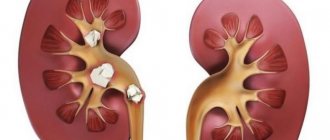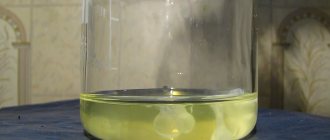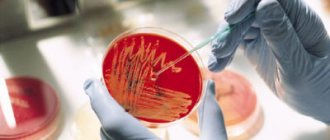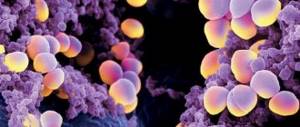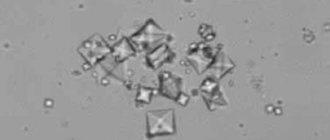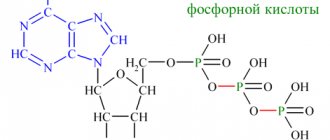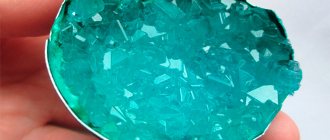During pregnancy, the load on a woman's kidneys increases significantly. That is why expectant mothers need to regularly undergo a general urine test. This simple but informative study will tell you a lot about the condition of the urinary system.
Sometimes laboratory technicians find oxalates in a urine sample. What is it, what are the reasons for their appearance, does their presence indicate the development of pathology, and what measures should be taken to prevent oxalate salts from appearing in the urine during pregnancy?
What are oxalates
Calcium salts - oxalates - along with other substances (such, for example, include the combination of pure calcium salts with orthophosphoric acid - phosphate) are a product of natural metabolic processes in the body, dissolved by fluid passed through the kidneys, excreted along with urine. A woman’s health depends on the balance of this substance - the concentration is a little more or a little less, and the condition will deteriorate, triggering the pathological process of development of the most serious diseases. If the kidneys cannot cope with the load, the salts are not excreted and begin to crystallize and turn into stones.
In the body of a healthy person, calcium is processed and excreted in a timely manner, in optimal volumes, so oxalate salts are found in the urine in a minimal amount. This balance can be upset by a number of factors:
- taking large amounts of vitamins;
- abundant consumption of vegetables;
- genetic predisposition;
- regular stress;
- diabetes mellitus;
- inflammatory and infectious diseases of the gastrointestinal tract;
- deficiency of magnesium salts.
Pregnancy is a difficult test for the female body - all the mother’s resources are directed to maintaining the development and protection of the fetus, all her organs and systems work on this task, often to the detriment of the woman herself, so even ordinary allergies can become a problem. For the development of a child, a large amount of calcium is required, which is produced by the mother's body. If the mother's kidneys do not function properly and do not provide enough water to dissolve and excrete the salts, this is the reason for their crystallization and precipitation in the urine.
Reasons for increased salt levels in the body of a pregnant woman
Before moving on to the symptoms of the presence of salts in the body and their treatment, you need to understand the reasons for their appearance during pregnancy, which include:
- Disturbances in the endocrine system.
- Low content of vitamin B6 in the body.
- An excess of vitamins is detected during testing.
- Unbalanced diet of the expectant mother, frequent consumption of foods high in vitamin C, D, as well as foods with a high level of oxalic acid.
- Malfunction of the digestive system, disruption of metabolic processes and intestinal function.
- Inflammatory bowel diseases - colitis.
- Corn's disease.
- Pyelonephritis.
- Urolithiasis, kidney dysfunction.
- Hereditary metabolic disorders.
- Toxin poisoning.
- Dehydration of the body.
Before starting treatment, you should undergo examinations prescribed by your doctor and take tests to identify the cause of oxaluria.
Kinds
The detection of oxalates during pregnancy often indicates pathological processes occurring in a woman’s body that affect the urinary system. The condition is dangerous because it practically does not manifest itself symptomatically, therefore it is detected only on the basis of a urine test and the results of instrumental examinations (ultrasound).
Several types of oxalates are commonly found in urine, each formed from salts of different types of substances. The most common are calcium oxalates, but concretions of crystallized potassium, ammonium and sodium salts combined with oxalic acid are also released. The formation of such stones is influenced by various factors - from improper diet to an excess of vitamins taken.
Recommended topic:
Medicines and drugs for sand in the kidneys
General information
Oxalates are salts or esters of oxalic acid. They are formed when it combines with inorganic elements: calcium, sodium, potassium, iron, magnesium. The metabolism of oxalic acid in the body occurs mainly in the intestines and kidneys. With a normal diet, up to 1 g of oxalate is supplied with food, the main part of which is excreted, and only 10% is absorbed unchanged into the blood. An important role in this process is played by individual representatives of the intestinal microflora - Oxalobacter formigenes. This microorganism regulates the level of oxalic acid, utilizing it in the process of its life.
But in addition to external intake, there is endogenous synthesis of oxalate, when it is formed by the metabolism of ascorbic or glyoxalic acids. Such products come at a rate of 1 mg per hour, occupying the main share in the exchange (70%). All oxalic acid is excreted in the urine, mainly binding to sodium and potassium. And when combined with calcium, it forms a practically insoluble salt, existing in the form of mono- or dihydrate. Calcium oxalate crystals are detected in many cases, including during pregnancy. Unlike other salts (urates or phosphates), they fall out with any reaction (pH) of urine.
Oxalates come from food or are synthesized in the body from other acids and are subsequently excreted by the kidneys.
Norm, deviation and its manifestation
The normal level of oxalate in the urine of a pregnant woman is 20-40 mg, which results in 1-2 pluses. At this concentration, a single crystal of calcium salts (doctors also call it urate), even if formed, will be removed from the body without problems. An increase in the volume of oxalate substances will already cause problems - excess salts concentrate in the soft tissues, increase in size, harden and turn into a calculus, which may mean the onset of urolithiasis.
There are no specific symptoms indicating that large quantities of oxalates are formed in the body of the expectant mother. Doctors recommend not to ignore the following signs:
- problem with frequent and excessive urination;
- manifestations of general muscle weakness;
- increased and rapid fatigue with sleep disturbances;
- sharp cutting pains occurring in the abdominal area;
- renal colic;
- detection of bloody inclusions in the urine.
If you experience such symptoms, you should immediately consult a doctor to undergo diagnostic tests and determine the degree of danger of the condition for the mother and child.
Treatment
In most cases, treatment takes place on an outpatient basis.
A pregnant woman is sent to a hospital only in case of acute health problems that entail a danger to the development and life of the child. If the amount of oxolates in the urine is not greatly exceeded, then treatment recommendations include adherence to dietary table No. 7, as well as the drinking regime.
A special place in oxolate therapy is occupied by regular physical activity. Moderate exercise helps their movement from the kidneys and removal from the body of the expectant mother.
In severe cases, drug therapy or surgery using laparoscopy is prescribed.
Diet and drink are the main methods of treatment
Since during pregnancy the main reason for the increase in the volume of calcium salts excreted in the urine is impaired kidney function, treatment of this condition consists of the following measures:
- diet - exclusion from the diet of foods containing oxalates in both significant and small quantities (cocoa, chocolate, any sweets, beets, lettuce, sorrel and spinach, citrus fruits, currants and rose hips, fatty broths);
- drinking regime - the volume of liquid should exceed 2-2.5 liters, you should drink mineral water, compotes, fruit drinks, herbal decoctions, infusions and preparations.
In addition to the listed measures, on the recommendation of doctors, pregnant women can take vitamin and mineral complexes:
- vitamin B6;
- magnesium oxide;
- citric acid;
- sodium and potassium citrate.
Recommended topic:
Microliths in the kidneys
All therapeutic measures must be carried out under the supervision of a doctor and in strict accordance with his prescriptions - self-medication can harm the expectant mother and her child, as well as aggravate problems with the genitourinary system.
Why do salts appear in urine?
Oxalate crystals are calcium or oxalic acid salts that normally appear in the body in small quantities and are natural products of metabolism. There are many reasons for the appearance of these formations in the urine in elevated concentrations, especially when it comes to the period of pregnancy by a woman. Among the most common factors contributing to oxalaturia during pregnancy are:
- eating foods enriched with oxalic acid;
- deficiency of magnesium and vitamin B6 in the body;
- dehydration;
- urolithiasis, as well as other pathologies of the renal sphere with impaired filtration and secretion function;
- genetic tendency to develop oxalosis (a hereditary form of oxalate metabolism disorder);
- hypervitaminosis caused by taking synthetic vitamins;
- stressful situations;
- endocrine diseases, in particular diabetes mellitus;
- bacterial enterocolitis, non-infectious inflammation of the intestinal mucosa, autoimmune damage to the digestive tract (Crohn's disease);
- conditions after surgical interventions on the intestines;
- the presence of toxins in the body.
Pregnancy at risk
In small amounts, oxalates in the urine during pregnancy are not an alarming sign, especially since after the first analysis that revealed these substances, you should undergo a repeat examination, which can confirm or refute the diagnosis. However, since the manifestation of urates is associated with a problem in the functioning of the kidneys, if the condition is neglected, it can harm the mother and her baby.
For a pregnant woman’s body, impaired kidney function means an increased load on the organ and a potential danger of intoxication of the body with substances that are no longer filtered by the urinary system. Also, problems with the kidneys are fraught with even greater accumulation of oxalates with their subsequent transformation into stones. And stones accumulated in the urinary system cause a number of problems. Every woman should know what this can mean:
- deformation of the renal nephrons and a decrease in filtration functions with changes in blood composition and disruption of the metabolic processes of producing nutrients for the fetus;
- renal failure (acute and chronic);
- blockage of the urinary tract (ureters), leading to disruption of the outflow of urine and the likelihood of developing inflammatory infectious lesions;
- general dysfunction of the urinary system.
Important: the danger of oxalates for women during pregnancy is that this situation does not allow treatment with medications - stones, if they have formed and began to cause concern, are removed exclusively by surgical methods.
Prevention of excess salt formation during pregnancy
An important part of preventative treatment is proper rehydration. You should not make or drink concentrated juices: you should give preference to clean water. Pregnant women are advised to limit the consumption of foods that contain a lot of oxalic acid - sorrel, soy. It is also necessary to take more dietary fiber as it reduces the bioavailability of oxalates.
Before starting treatment, you should consult your doctor. It is forbidden to take folk remedies, as they can have unpredictable and harmful effects on pregnancy. A timely visit to a nephrologist, urologist or gynecologist not only helps eliminate the complications that have arisen, but also completely get rid of the disorder.
Prevention measures
The main way to correct the condition of pregnant women who have increased the usually moderate level of oxalate in the urine is a diet that includes:
- lean boiled meat;
- porridge;
- dairy products;
- wholemeal bread.
Proper nutrition, which reduces the amount of calcium salts, as well as an optimal drinking regimen, will eliminate the likelihood of developing problems with the urinary system in the future.
The presence of oxalates in the urine may simply mean that the expectant mother is not eating properly and taking too many vitamins, however, the same condition often demonstrates the presence of problems with the genitourinary system (and sometimes also the gastrointestinal tract) in the woman’s body. To exclude the possibility of developing diseases, it is recommended to undergo examination and begin timely treatment. It is important to remember that oxalates are a potential danger to mother and baby.
Symptoms
The most common symptoms due to which you can independently suspect the presence or absence of this pathology in pregnant women are:
- Frequent painful urge to go to the toilet (more than 15 times a day).
- Constant feeling of fatigue, drowsiness.
- Headaches, possible loss of consciousness and dizziness.
- Change in urine color.
- Sharp, short-lived pain in the lower abdomen, which is sometimes mistaken for colic.
- Slightly elevated temperature.
It is important to note the fact that such changes are often accompanied by a sudden change in diet.
With the slow development of the disease, the above symptoms may be mild or not expressed at all.
In such cases, there is a possibility that the disease will develop hidden. Late diagnosis and untimely treatment will not contribute to successful treatment.
What should you not eat?
To achieve a speedy recovery or alleviate the patient’s condition, doctors often prescribe a therapeutic diet. It is not rigid, so it will be quite easy to follow. At the same time, all family members must ensure that the pregnant woman does not consume prohibited foods , namely:
- Tea coffee;
- sorrel;
- parsley;
- beet;
- gelatin;
- radish;
- plums;
- chocolate;
- cocoa;
- legumes
A more complete list of unwanted products will be announced by your doctor at your appointment. You should not decide to use any medications on your own. Elevated levels of calcium oxalate in the urine are a problem that does not require drug treatment. The patient simply needs to adhere to the basic principles of the diet prescribed by the doctor.

